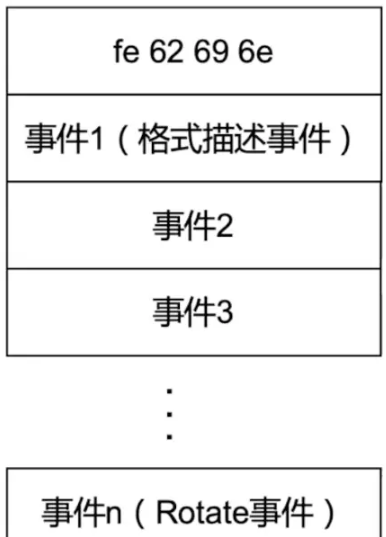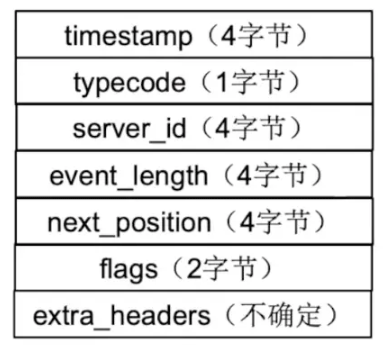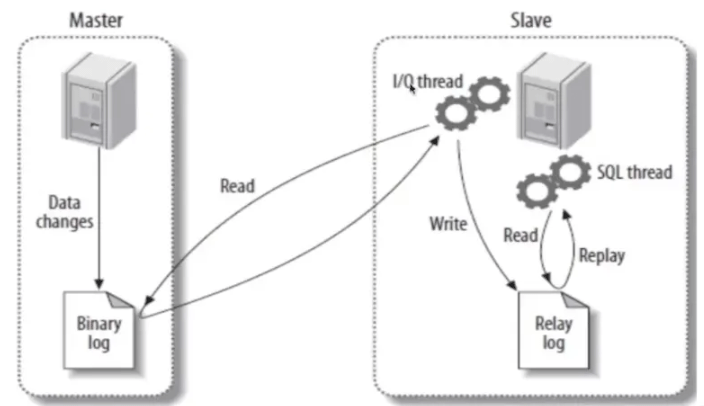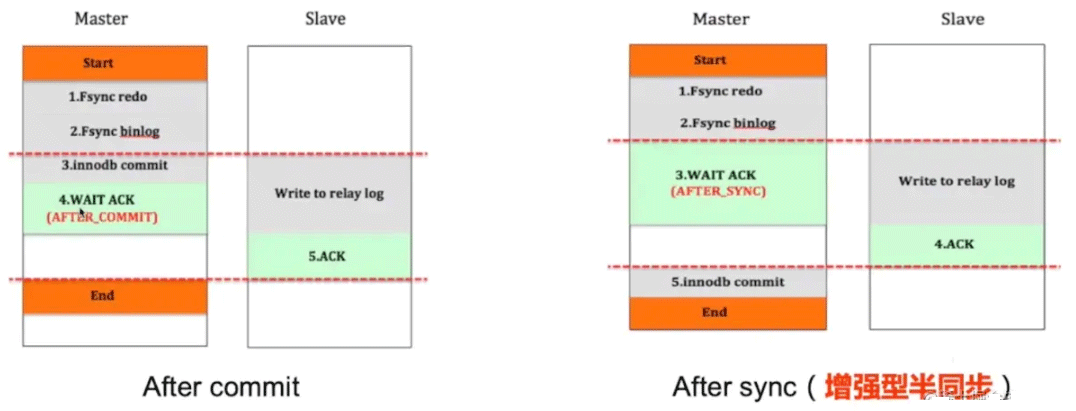What are MySQL Binlog logs and master-slave replication?
1. Introduction to Binlog log
Binlog is the abbreviation of Binary log, that is, binary log. The three main functions of Binlog include converting random IO into sequential IO for persistence, realizing master-slave replication and supporting data recovery. This article focuses on issues related to master-slave replication.
Binlog log consists of an index file and many log files. Each log file consists of a magic number and an event. Each log file ends with a Rotate type event.

For each event, it can be divided into two parts: event header and event body:
The event header The structure is as follows:

The structure of the event body includes two parts: fixed size and variable size.
As for the format of Binlog log, you can have a simple understanding. Interested students can study in depth.
2. Master-slave replication
2.1 Master-slave replication process

MySQL master-slave replication process is roughly as follows:
The main library synchronizes its own Binlog log to the slave library
The IO thread of the slave library writes the Binlog log content to the Relay Log
Get the Relay Log from the SQL thread of the library and play it back in the database
2.2 GTID
GTID refers to the global Transaction flag, used to mark master-slave synchronization.
When the master node submits a transaction, a GTID will be generated and recorded in the Binlog log. When the IO thread of the slave library reads the Binlog log, it will store it in its own Relaylog and set this value to gtid_next, which is the next GTID to be read. When reading this gtid_next from the library, it will compare Whether there is this GTID in your Binlog log:
If there is this record, it means that the transaction with this GTID has been executed and can be ignored (idempotent).
If there is no such record, the slave will execute the GTID transaction and record it in its own Binlog log.
2.3 Replication model
Asynchronous replication: master pushes the Binlog log to the slave, and the master does not need to wait until the slave After successfully updating the data to the Relay log, the main database can directly submit the transaction. This mode sacrifices data consistency.
Synchronous replication: Every time the user operates, it must be ensured that both the Master and Slave are executed successfully before returning it to the user.
Semi-synchronous replication: does not require the Slave to execute successfully, but can notify the Master to return after successfully receiving the Master log.

2.4 MGR mode
Distributed consensus algorithm Paxos. A database cluster consists of at least 3 or more nodes. Transaction submission must be approved by more than half of the nodes before it can be submitted. Multi-write mode is supported.
MGR is a share-nothing replication solution, implemented based on the distributed paxos protocol. Each instance has an independent complete copy of the data. The cluster automatically checks node information and synchronizes data. Both single-master mode and multi-master mode are provided. The single-master mode can automatically select the master after the main database goes down. All writes are performed on the master node. The multi-master mode supports multi-node writing. The cluster provides fault tolerance. As long as most nodes are running normally, the cluster can provide services normally.
2.5 Parallel playback
Transaction playback is the process of executing Relay Log from the SQL thread of the library. Parallel playback is to improve the efficiency of this process and perform transactions that can be carried out in parallel at the same time.
Parallel playback based on logical clock
Because MySQL's own transactions have ACID characteristics, the transactions from the master database to the slave database are synchronized. As long as the logical timing of their execution overlaps, the two transactions can be safely played back in parallel.
Parallel playback based on writeSet
Store the transaction set regarding a specific data block area within a certain period of time in a HashMap. Conflicts do not occur between transactions within the same group or between transactions with overlapping logical clocks, and otherwise it is impossible to determine whether a conflict exists.
The above is the detailed content of What are MySQL Binlog logs and master-slave replication?. For more information, please follow other related articles on the PHP Chinese website!

Hot AI Tools

Undresser.AI Undress
AI-powered app for creating realistic nude photos

AI Clothes Remover
Online AI tool for removing clothes from photos.

Undress AI Tool
Undress images for free

Clothoff.io
AI clothes remover

AI Hentai Generator
Generate AI Hentai for free.

Hot Article

Hot Tools

Notepad++7.3.1
Easy-to-use and free code editor

SublimeText3 Chinese version
Chinese version, very easy to use

Zend Studio 13.0.1
Powerful PHP integrated development environment

Dreamweaver CS6
Visual web development tools

SublimeText3 Mac version
God-level code editing software (SublimeText3)

Hot Topics
 1378
1378
 52
52
 MySQL: The Ease of Data Management for Beginners
Apr 09, 2025 am 12:07 AM
MySQL: The Ease of Data Management for Beginners
Apr 09, 2025 am 12:07 AM
MySQL is suitable for beginners because it is simple to install, powerful and easy to manage data. 1. Simple installation and configuration, suitable for a variety of operating systems. 2. Support basic operations such as creating databases and tables, inserting, querying, updating and deleting data. 3. Provide advanced functions such as JOIN operations and subqueries. 4. Performance can be improved through indexing, query optimization and table partitioning. 5. Support backup, recovery and security measures to ensure data security and consistency.
 How to open phpmyadmin
Apr 10, 2025 pm 10:51 PM
How to open phpmyadmin
Apr 10, 2025 pm 10:51 PM
You can open phpMyAdmin through the following steps: 1. Log in to the website control panel; 2. Find and click the phpMyAdmin icon; 3. Enter MySQL credentials; 4. Click "Login".
 MySQL: Simple Concepts for Easy Learning
Apr 10, 2025 am 09:29 AM
MySQL: Simple Concepts for Easy Learning
Apr 10, 2025 am 09:29 AM
MySQL is an open source relational database management system. 1) Create database and tables: Use the CREATEDATABASE and CREATETABLE commands. 2) Basic operations: INSERT, UPDATE, DELETE and SELECT. 3) Advanced operations: JOIN, subquery and transaction processing. 4) Debugging skills: Check syntax, data type and permissions. 5) Optimization suggestions: Use indexes, avoid SELECT* and use transactions.
 How to create navicat premium
Apr 09, 2025 am 07:09 AM
How to create navicat premium
Apr 09, 2025 am 07:09 AM
Create a database using Navicat Premium: Connect to the database server and enter the connection parameters. Right-click on the server and select Create Database. Enter the name of the new database and the specified character set and collation. Connect to the new database and create the table in the Object Browser. Right-click on the table and select Insert Data to insert the data.
 MySQL and SQL: Essential Skills for Developers
Apr 10, 2025 am 09:30 AM
MySQL and SQL: Essential Skills for Developers
Apr 10, 2025 am 09:30 AM
MySQL and SQL are essential skills for developers. 1.MySQL is an open source relational database management system, and SQL is the standard language used to manage and operate databases. 2.MySQL supports multiple storage engines through efficient data storage and retrieval functions, and SQL completes complex data operations through simple statements. 3. Examples of usage include basic queries and advanced queries, such as filtering and sorting by condition. 4. Common errors include syntax errors and performance issues, which can be optimized by checking SQL statements and using EXPLAIN commands. 5. Performance optimization techniques include using indexes, avoiding full table scanning, optimizing JOIN operations and improving code readability.
 How to create a new connection to mysql in navicat
Apr 09, 2025 am 07:21 AM
How to create a new connection to mysql in navicat
Apr 09, 2025 am 07:21 AM
You can create a new MySQL connection in Navicat by following the steps: Open the application and select New Connection (Ctrl N). Select "MySQL" as the connection type. Enter the hostname/IP address, port, username, and password. (Optional) Configure advanced options. Save the connection and enter the connection name.
 How to recover data after SQL deletes rows
Apr 09, 2025 pm 12:21 PM
How to recover data after SQL deletes rows
Apr 09, 2025 pm 12:21 PM
Recovering deleted rows directly from the database is usually impossible unless there is a backup or transaction rollback mechanism. Key point: Transaction rollback: Execute ROLLBACK before the transaction is committed to recover data. Backup: Regular backup of the database can be used to quickly restore data. Database snapshot: You can create a read-only copy of the database and restore the data after the data is deleted accidentally. Use DELETE statement with caution: Check the conditions carefully to avoid accidentally deleting data. Use the WHERE clause: explicitly specify the data to be deleted. Use the test environment: Test before performing a DELETE operation.
 How to execute sql in navicat
Apr 08, 2025 pm 11:42 PM
How to execute sql in navicat
Apr 08, 2025 pm 11:42 PM
Steps to perform SQL in Navicat: Connect to the database. Create a SQL Editor window. Write SQL queries or scripts. Click the Run button to execute a query or script. View the results (if the query is executed).




